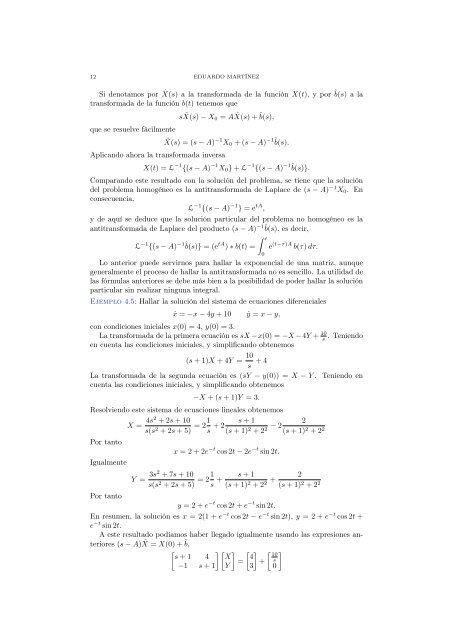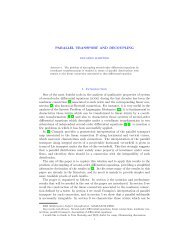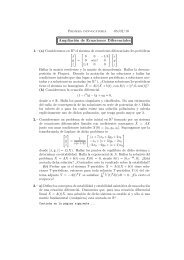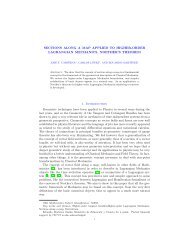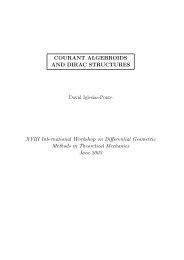TRANSFORMADA DE LAPLACE Estudiamos en este capítulo la ...
TRANSFORMADA DE LAPLACE Estudiamos en este capítulo la ...
TRANSFORMADA DE LAPLACE Estudiamos en este capítulo la ...
You also want an ePaper? Increase the reach of your titles
YUMPU automatically turns print PDFs into web optimized ePapers that Google loves.
12 EDUARDO MARTÍNEZ<br />
Si d<strong>en</strong>otamos por ˆ X(s) a <strong>la</strong> transformada de <strong>la</strong> función X(t), y por ˆ b(s) a <strong>la</strong><br />
transformada de <strong>la</strong> función b(t) t<strong>en</strong>emos que<br />
que se resuelve fácilm<strong>en</strong>te<br />
Aplicando ahora <strong>la</strong> transformada inversa<br />
s ˆ X(s) − X0 = A ˆ X(s)+ ˆ b(s),<br />
ˆX(s) =(s − A) −1 X0 +(s − A) −1ˆ b(s).<br />
X(t) =L −1 {(s − A) −1 X0} + L −1 {(s − A) −1ˆ b(s)}.<br />
Comparando <strong>este</strong> resultado con <strong>la</strong> solución del problema, se ti<strong>en</strong>e que <strong>la</strong> solución<br />
del problema homogéneo es <strong>la</strong> antitransformada de Lap<strong>la</strong>ce de (s − A) −1 X0. En<br />
consecu<strong>en</strong>cia,<br />
L −1 {(s − A) −1 } =e tA ,<br />
y de aquí se deduce que <strong>la</strong> solución particu<strong>la</strong>r del problema no homogéneo es <strong>la</strong><br />
antitransformada de Lap<strong>la</strong>ce del producto (s − A) −1ˆb(s), es decir,<br />
L −1 {(s − A) −1ˆ<br />
� t<br />
tA<br />
b(s)} = (e ) ∗ b(t) = e (t−τ)A b(τ) dτ.<br />
Lo anterior puede servirnos para hal<strong>la</strong>r <strong>la</strong> expon<strong>en</strong>cial de una matriz, aunque<br />
g<strong>en</strong>eralm<strong>en</strong>te el proceso de hal<strong>la</strong>r <strong>la</strong> antitransformada no es s<strong>en</strong>cillo. La utilidad de<br />
<strong>la</strong>s fórmu<strong>la</strong>s anteriores se debe más bi<strong>en</strong> a <strong>la</strong> posibilidad de poder hal<strong>la</strong>r <strong>la</strong> solución<br />
particu<strong>la</strong>r sin realizar ninguna integral.<br />
Ejemplo 4.5: Hal<strong>la</strong>r <strong>la</strong> solución del sistema de ecuaciones difer<strong>en</strong>ciales<br />
˙x = −x − 4y + 10 ˙y = x − y,<br />
con condiciones iniciales x(0) = 4, y(0) = 3.<br />
La transformada de <strong>la</strong> primera ecuación es sX −x(0) = −X −4Y + 10<br />
s . T<strong>en</strong>i<strong>en</strong>do<br />
<strong>en</strong> cu<strong>en</strong>ta <strong>la</strong>s condiciones iniciales, y simplificando obt<strong>en</strong>emos<br />
(s + 1)X +4Y = 10<br />
s +4<br />
La transformada de <strong>la</strong> segunda ecuación es (sY − y(0)) = X − Y . T<strong>en</strong>i<strong>en</strong>do <strong>en</strong><br />
cu<strong>en</strong>ta <strong>la</strong>s condiciones iniciales, y simplificando obt<strong>en</strong>emos<br />
−X +(s + 1)Y =3.<br />
Resolvi<strong>en</strong>do <strong>este</strong> sistema de ecuaciones lineales obt<strong>en</strong>emos<br />
X = 4s2 +2s + 10<br />
s(s2 +2s + 5) =21<br />
s +2<br />
s +1<br />
(s + 1) 2 − 2<br />
+22 Por tanto<br />
Igualm<strong>en</strong>te<br />
Por tanto<br />
x = 2 + 2e −t cos 2t − 2e −t sin 2t.<br />
Y = 3s2 +7s + 10<br />
s(s 2 +2s + 5) =21<br />
s +<br />
0<br />
s +1<br />
(s + 1) 2 +<br />
+22 y = 2 + e −t cos 2t + e −t sin 2t.<br />
2<br />
(s + 1) 2 +2 2<br />
2<br />
(s + 1) 2 +2 2<br />
En resum<strong>en</strong>, <strong>la</strong> solución es x = 2(1 + e −t cos 2t − e −t sin 2t), y = 2 + e −t cos 2t +<br />
e −t sin 2t.<br />
A <strong>este</strong> resultado podíamos haber llegado igualm<strong>en</strong>te usando <strong>la</strong>s expresiones an-<br />
teriores (s − A) ˆ X = X(0) + ˆb, � �� �<br />
s + 1 4 X<br />
=<br />
−1 s +1 Y<br />
� �<br />
4<br />
+<br />
3<br />
� �<br />
10<br />
s<br />
0


